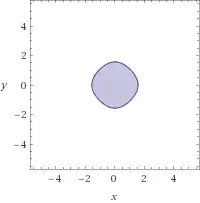What is the area of the region $\cos x+\cos y > 1$, where $|x|,|y|<\pi$?
In other words, is there a "closed" form -- using functions that are well-known and nice to work with -- for this integral? $$4\int_0^{\pi/2}\cos^{-1}(1-\cos x)\,dx = 7.2948823845\ldots$$
I can approximate it pretty well:
>>> scipy.integrate.quad(func=lambda x: math.acos(1-math.cos(x)),
... a=0, b=math.pi/2,
... epsabs=1e-14, epsrel=1e-13, limit=200)
(1.8237205961260357, 1.0436096431476471e-14)
times 4:
(7.294882384504143, 4.1744385725905886e-14)
These numbers don't appear in Inverse Symbolic Calculator, OEIS, or Google.
I ask this question because finding the area of $(\cos x + \cos y > M)$ for a variable $M$ is an intermediate step towards a solution to this question: What is the chance that an $n$-gon whose vertices lie randomly on a circle's circumference covers a majority of the circle's area? I figure that if there's any chance that this area is a reasonable function of $M$, then it should have a reasonable value when $M=1$!
Edit: In the comments, LCFactorization found this form: $$\frac{8}{9\sqrt{\pi}}\left( 9\Gamma\left(\frac{3}{4}\right)^2{}_4F_3\left( \begin{array}{c}\frac14,\frac14,\frac34,\frac34\\\frac12,\frac54,\frac54\end{array};\frac14\right) + \Gamma\left(\frac{5}{4}\right)^2{}_4F_3\left( \begin{array}{c}\frac34,\frac34,\frac54,\frac54\\\frac32,\frac74,\frac74\end{array};\frac14\right) \right)$$ How can we humans derivate that expression from the integral? And can it be simplified?
Edit2: And how can one get a symbolic integration engine to handle such an integral? In Mathematica, the inputs Integrate[
Boole[Cos[x] + Cos[y] > 1], {x, -Pi/2, Pi/2}, {y, -Pi/2, Pi/2}] and Integrate[ArcCos[1 - Cos[x]], {x, 0, Pi/2}] just output integrals again. How do you hint to it to try crazy hypergeometric functions?


Mathematicaand obtained: $$\frac{8}{9\sqrt{\pi}}\left(9\Gamma\left(\frac{3}{4}\right)^2_4\cdot{\rm{HypergeometricPFQ}}\left(\color{blue}{\frac{1}{4},\frac{1}{4},\frac{3}{4},\frac{3}{4}};\frac{1}{2},\frac{5}{4},\frac{ 5}{4};\color{red}{\frac{1}{4}}\right)+\Gamma\left(\frac{5}{4}\right)^2_4\cdot{\rm{HypergeometricPFQ}}\left(\color{blue}{\frac{3}{4},\frac{3}{4},\frac{5}{4},\frac{5}{4}};\frac{3}{2},\frac{7}{4},\frac{7}{4};\color{red}{\frac{1}{4}}\right)\right)$$ – LCFactorization Aug 13 '17 at 08:351/(9 Sqrt[\[Pi]])8 (9 Gamma[3/4]^2 HypergeometricPFQ[{1/4,1/4,3/4,3/4},{1/2,5/4,5/4},1/4]+Gamma[5/4]^2 HypergeometricPFQ[{3/4,3/4,5/4,5/4},{3/2,7/4,7/4},1/4])– LCFactorization Aug 13 '17 at 09:25Integrate[ArcCos[1 - Cos[x]], {x, 0, Pi/2}]on 11.0, and it took about an hour trying to evaluate it, finally just echoing the same expression as output. – Chris Culter Aug 15 '17 at 19:35